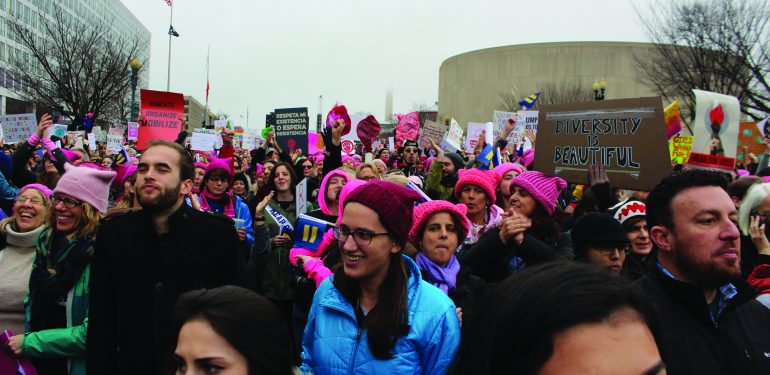BY LOTTYE LOCKHART | Office of Student Media
As a child, my mother was brought to a picket line. There, the people that she had grown up around marched for her right to attend an integrated school in New York City.
Her mother brought her and explained that she would do whatever it took to get my mother the best possible education. She believed that, because she showed up for that and every other march in their area, her daughter would have a better life than she had.
Nearly 50 years later, on Jan. 21, 2017, my mother and I went to D.C. to participate in the Women’s March on Washington.
Before even getting to the march, at the Vienna Metro station, my mother and I were immediately surrounded by women and some men — many with homemade signs. Shortly after we arrived, older women came in with free “pussy” hats — pink hats with cat ears, a reference to lewd remarks made by President Trump.
As we got on the Metro, the conductor let everyone know that some stations were shut down for the day, due to “an event on the National Mall.” His comment was greeted by smirks and glances between us passengers as we chuckled.
The first friends my mother and I made were the people sitting around us in our Metro car. One girl, in high school, was attending the march with her father because her mother, a professor, was in London. Another woman inadvertently let us know it was her birthday, and the entire car sang to her (led by a music teacher sitting behind me).
As a car, we talked about how we had made our signs, who had been on the road the longest and our jobs. Once we were in D.C., people began to get off at the stations where their friends and families were waiting. Caught up in the excitement already, each time a group of us got off, the train broke out into cheers.
When we finally got to the stage near the Capitol building, we stood for a moment. The crowd was already huge — there were students climbing on walls outside of the Smithsonian Air and Space Museum. Photographers pulled dangerous stunts, climbing unsteady trees and signs to see above the crowd and get good angles.
My mother and I worked our way closer to the front. Finding other people we knew was difficult, as, thanks to the large number of people who showed up, there was no cell phone service.
Eventually, my mother and I decided we were close enough to the front, and we found a good way to find each other if we did get separated. We would simply look for the woman near us with the giant sign that covered nearly every issue.
From the bees, to the Dakota Access Pipeline, to healthcare, to Planned Parenthood, everything was covered. The sign-holder was a makeup artist who had come from several states away with a group on a bus. She had made her sign out of PVC pipe, and it included a place to hold her chapstick and her tea. “I know, I’m so lazy,” she said, underneath the double sided, hand painted sign she spent five weeks creating.
Nearby was a young girl with her mother and her mother’s friend. She was shy and tired. But when someone put her on their shoulders so she could see and hold up a sign, she brightened up. She continued to smile when people asked repeatedly for her picture.
Most of the march was a blur to me, in part from the feeling of unity from just being there, but also because when the time came to march, I realized we were so surrounded that there was nowhere for us to march to.
I was not at this march for the speakers or the free t-shirts. I went because when the world that I know and acknowledge begins to become unfair again, repeating the history that my grandmother and great-grandmother and even further back than that lived through, I know I must do something.
Lottye Lockhart is part of the PR team at the Office of Student Media.




